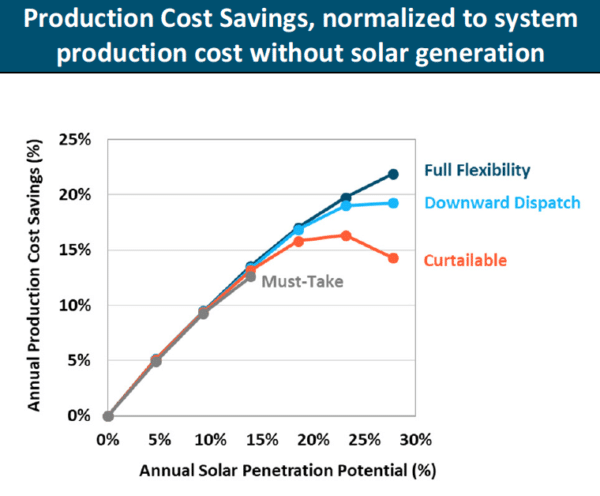Installing solar of at least 28% of annual generation potential would yield substantial operational cost savings for a small Florida utility, if solar plants were operated in a “full flexibility” mode. That’s double the maximum feasible 14% of solar if operated in a “must run” mode, and well above the 19% of solar that provides substantial cost savings if operated in a “curtailable” mode.
In the full flexibility mode, grid operators to schedule in advance both solar curtailment and increased solar production—the latter by operating a solar plant at some level of curtailment, and then reducing curtailment to increase generation.
These are the results of a study sponsored by First Solar and conducted by modeling firm Energy+Environmental Economics, which used the PLEXOS model to simulate adding solar to the Tampa Electric Company’s service area, under four different operating modes.
 The cost savings from operating solar in full flexibility mode came from reduced fossil fuel use, grid services (as described in a First Solar/CAISO/NREL study), and reduced solar curtailment.
The cost savings from operating solar in full flexibility mode came from reduced fossil fuel use, grid services (as described in a First Solar/CAISO/NREL study), and reduced solar curtailment.
This graph shows that in the full flexibility mode, adding solar keeps providing marginal production cost savings through the 28% level, while other modes do not:
The four modes evaluated are:
- “Must-take” mode, where the solar plant generates all of its potential output, and the grid operator meets the resulting “net load” with other “dispatchable” resources.
- “Curtailable” mode, where unscheduled curtailment is an option.
- “Downward dispatch” mode, where curtailment scheduled in advance is an option.
- “Full flexibility” mode, where both curtailment and increased solar generation can be scheduled in advance.
Given that distributed rooftop solar now operates in “must take” mode, the authors contend that reaching high penetrations of rooftop solar will require some control of these resources, including operator dispatch signals, pricing mechanisms, local autonomous control, or other control methods.
Because operating solar plants in full flexibility mode provides many of the same grid services that storage can provide, this reduces the operational value of storage on the grid, the report says. However, the report notes that there is still a significant role for storage to play at high solar penetrations, due to increased balancing requirements, increased solar curtailment, and the ability of storage to provide significant system capacity value.
The report concludes that “dispatching renewables helps to retain their value at higher penetrations, which may induce further renewable deployment.” From an operating standpoint, it notes that “reducing operational costs and CO2 emissions from the power system is easier when solar power is treated as an active participant in grid balancing rather than an invisible part of the ‘net load.’”
In the utility studied, feasible solar in the “must run” mode topped out at 14% because of “unavoidable oversupply during low demand periods” at higher levels of solar. The analysis did not consider levels of solar above 28%. The study evaluated only operational cost savings only, and did not compare these savings to the capital costs of adding solar.
The study credits a 2014 study, led by the European Wind Energy Association and funded by the European Union, as the earliest study to simulate full flexibility operating mode.
This content is protected by copyright and may not be reused. If you want to cooperate with us and would like to reuse some of our content, please contact: editors@pv-magazine.com.








By submitting this form you agree to pv magazine using your data for the purposes of publishing your comment.
Your personal data will only be disclosed or otherwise transmitted to third parties for the purposes of spam filtering or if this is necessary for technical maintenance of the website. Any other transfer to third parties will not take place unless this is justified on the basis of applicable data protection regulations or if pv magazine is legally obliged to do so.
You may revoke this consent at any time with effect for the future, in which case your personal data will be deleted immediately. Otherwise, your data will be deleted if pv magazine has processed your request or the purpose of data storage is fulfilled.
Further information on data privacy can be found in our Data Protection Policy.